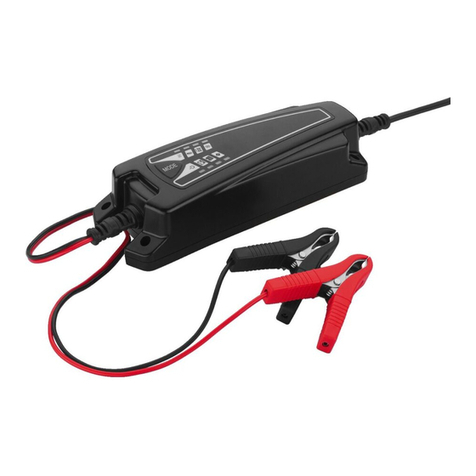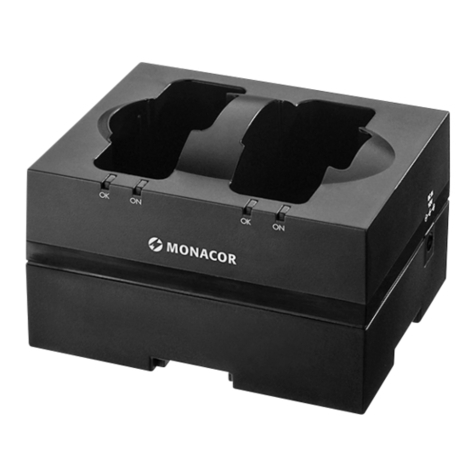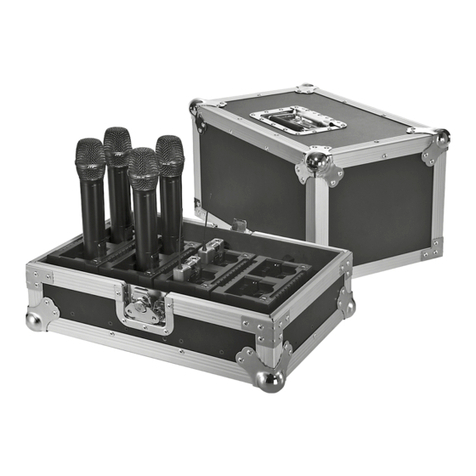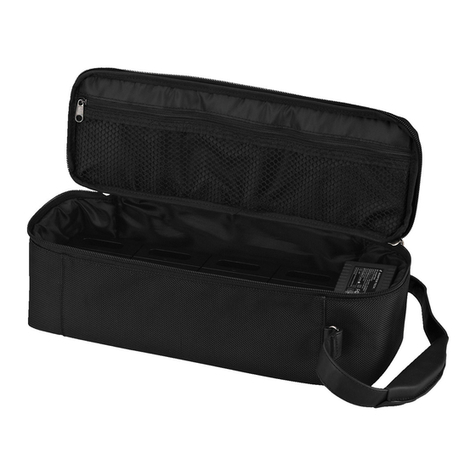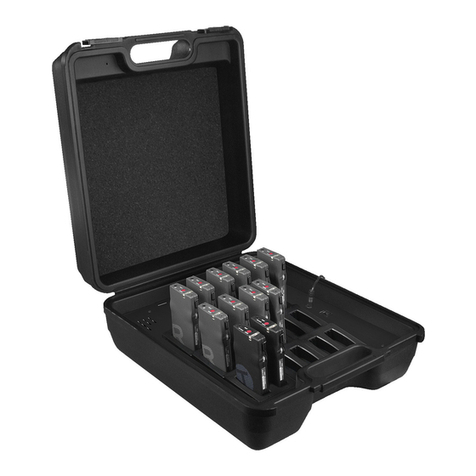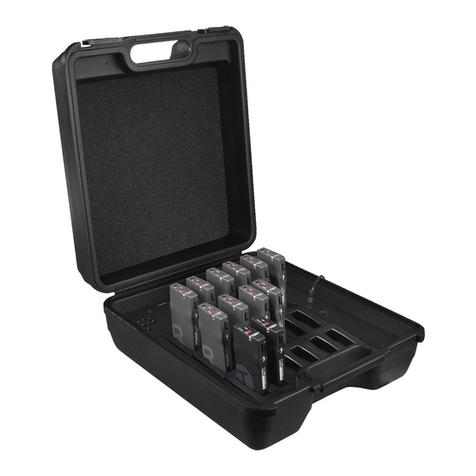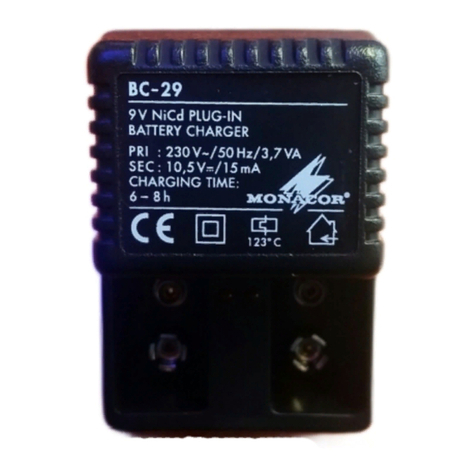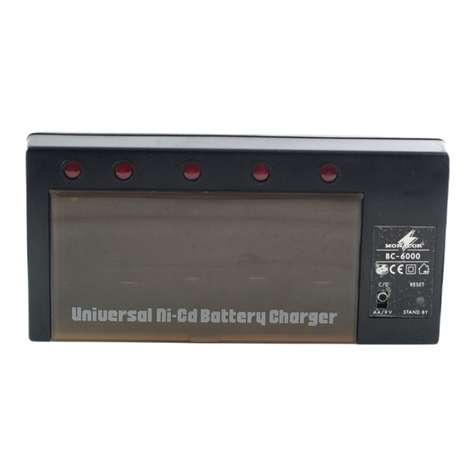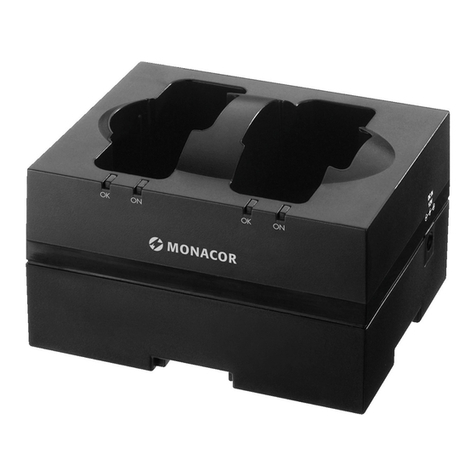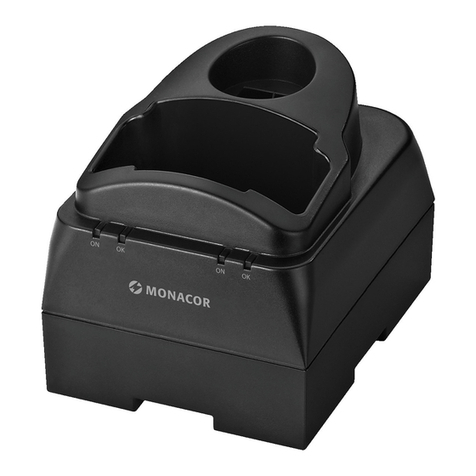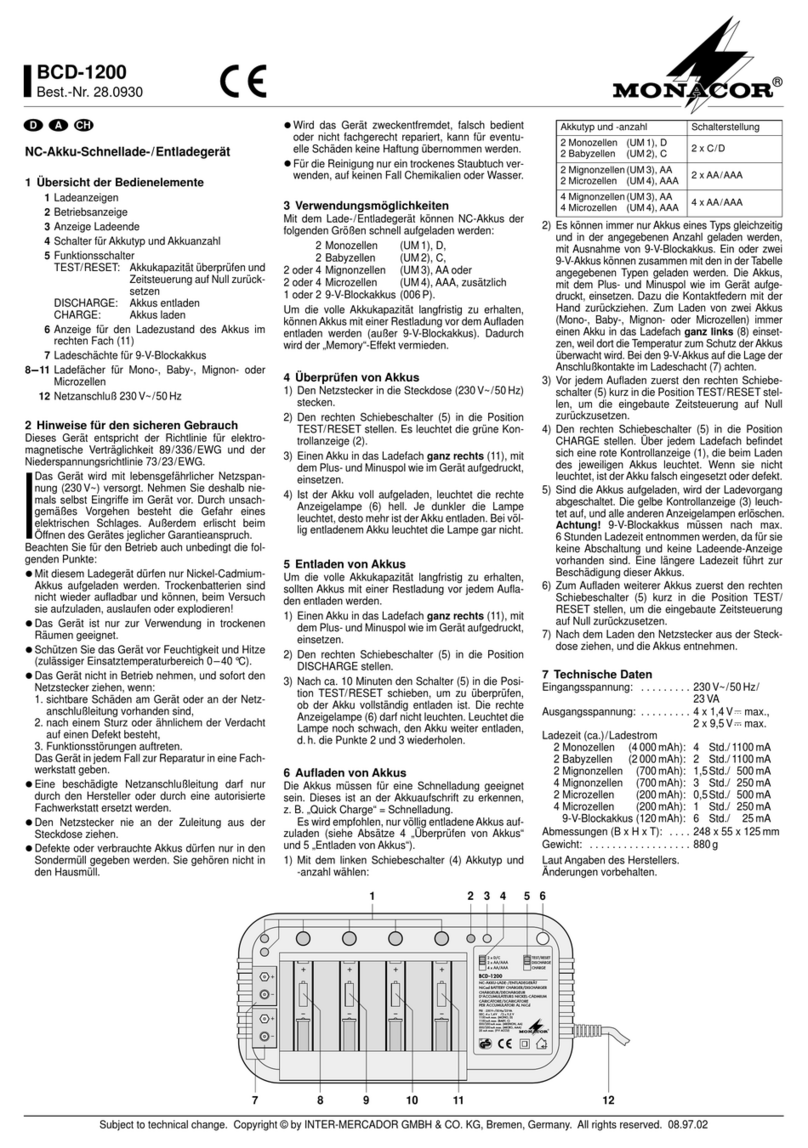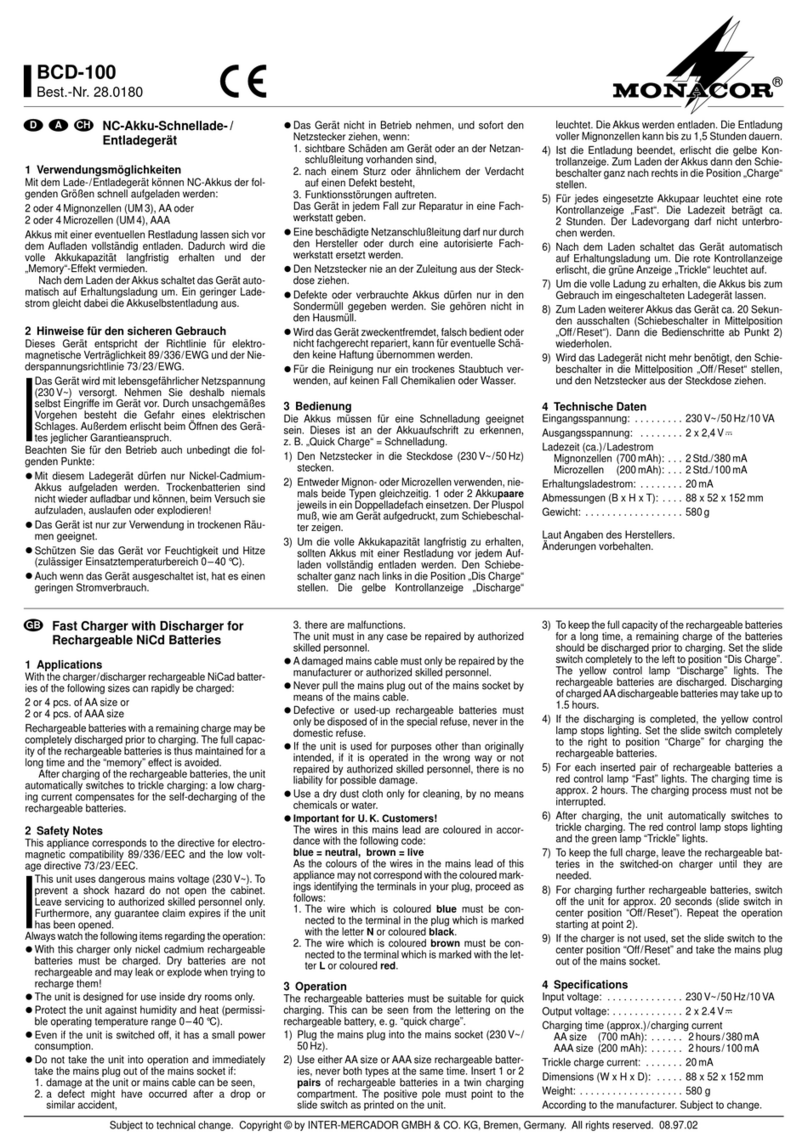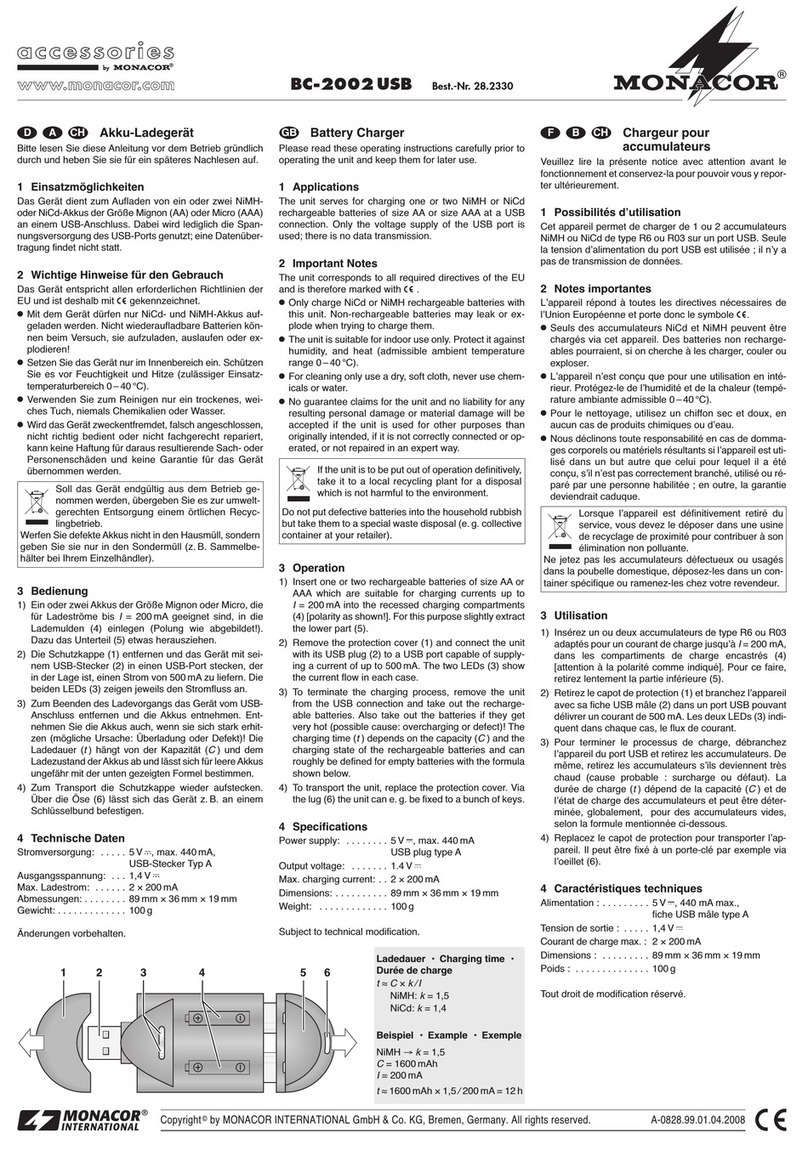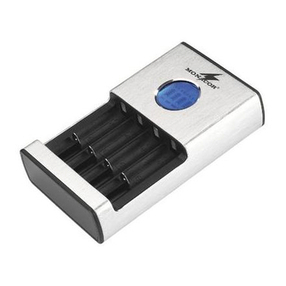
®
Vertrieb von JTS-Produkten – Distribution of JTS products
MONACOR INTERNATIONAL GmbH & Co. KG, Zum Falsch 36, 28307 Bremen, Germany
Copyright©by MONACOR INTERNATIONAL. All rights reserved. A-1700.99.02.10.2019
www.jts-europe.com
Estas instrucciones van dirigidas a usuarios
sin ningún conocimiento técnico especí-
fico. Lea atentamente estas instrucciones
antes del funcionamiento y guárdelas para
usos posteriores.
1 Aplicaciones
La estación de carga está diseñada para los emisores
– UF-20TB/5, R-4TBM/5, RU-G3TB/5
(emisores de petaca)
– JSS-20/5, JSS-4B/5
(micrófonos de mano inalámbricos)
La estación de carga se utiliza para cargar las baterías
NiMH que se hayan insertado en los emisores. Tiene
dos ranuras de carga que permiten cargar las baterías
de dos emisores al mismo tiempo.
2 Notas de Seguridad
Los aparatos (estación de carga y alimentador) cumplen
con todas las directivas relevantes de la UE y por lo
tanto están marcados con el símbolo .
ADVERTENCIA: El alimentador utiliza un
voltaje peligroso. Deje el mantenimiento en
manos del personal cualificado. El manejo
inexperto puede provocar una descarga.
•
Utilice esta estación de carga solamente para cargar
baterías NiMH. Si intenta cargar baterías no recarga-
bles, podrían derramarse o incluso explotar.
•
Inserte sólo baterías del mismo tipo en el emisor y
siempre remplace las baterías por parejas.
•
Los aparatos están adecuados para su aplicación sólo
en interiores. Protéjalos contra goteos, salpicaduras y
humedad elevada. Rango de temperatura ambiente
admisible: 0–40ºC.
•
El calor generado en el interior de la estacíon de carga
tiene que disiparse con la circulación del aire. Así
pues, no cubra las rejillas de ventilación de la carcasa.
•
Desconecte inmediatamente el alimentador de la
toma de corriente si:
1. El alimentador o la estación de carga están visi-
blemente dañados.
2. El aparato ha sufrido daños después de una caída
o accidente similar.
3. No funciona correctamente.
Sólo el personal técnico puede reparar los aparatos
bajo cualquier circunstancia.
•
Utilice sólo un paño suave y seco para la limpieza; no
utilice nunca ni agua ni productos químicos.
•
No podrá reclamarse garantía o responsabilidad
alguna por cualquier daño personal o material re-
sultante si los aparatos se utilizan para otros fines
diferentes a los originalmente concebidos, si no se
conectan correctamente, no se utilizan adecuada-
mente o no se reparan por expertos.
Si va a poner los aparatos fuera de servicio de-
finitivamente, llévelos a la planta de reciclaje
más cercana para que su eliminación no sea
perjudicial para el medioambiente.
No deposite nunca las baterías gastadas en el contene-
dor normal. Llévelas siempre a un contenedor especiali-
zado, p. ej. el contenedor selectivo de su tienda.
3 Cargar las Baterías
1)
Conecte el alimentador a la toma de la parte posterior
de la estación de carga y a un enchufe (230V/50Hz).
De este modo, se conecta la estación. Mientras esté
vacía una ranura de carga, su LED de carga se
iluminará en verde.
2)
Inserte el micrófono inalámbrico/emisor de petaca
en la ranura de carga con su visualizador mirando
hacia el frente de la estación de carga. ¡Inserte sólo
un aparato en cada ranura! Mientras se cargue las
baterías, el LED parpadeará en verde. Si el LED
“Alert” empieza a parpadear en rojo, significa que
ha habido un error (p.ej. batería defectuosa).
3)
Cuando las baterías se hayan cargado completa-
mente, el LED se iluminará permanentemente en
verde de nuevo. Quite el aparato de la ranura.
4) Para desconectar la estación de carga, desconecte el
alimentador de la toma de corriente.
4 Especificaciones
Tiempo de carga: . aprox. 3 horas para baterías rec.
de 2000mAh
Alimentación: . . . . mediante alimentador entregado
y conectado a 230V/50Hz
Dimensiones: . . . . 165 × 72 × 99 mm (B × H × P)
Peso:. . . . . . . . . . . 315 g
Sujeto a modificaciones técnicas.
Cette notice s’adresse aux utilisateurs sans
connaissances techniques particulières.
Veuillez lire avec attention la notice avant
le fonctionnement et conservez-la pour
pouvoir vous y reporter ultérieurement.
1 Possibilités d’utilisation
La station de charge est conçue pour les émetteurs
– UF-20TB/5, R-4TBM/5, RU-G3TB/5 (émetteurs de
poche)
– JSS-20/5, JSS-4B/5 (microphones main sans fil)
La station de charge permet de charger des accumula-
teurs NiMH (nickel-hydrure métallique) insérés dans les
émetteurs. Deux compartiments de charge permettent
de charger simultanément les accumulateurs de deux
émetteurs.
2 Conseils de sécurité
Les appareils (station de charge et bloc secteur) ré-
pondent à toutes les directives nécessaires de l’Union
européenne et porte donc le symbole .
AVERTISSEMENT : Le bloc secteur est ali-
menté par une tension dangereuse. Ne tou-
chez jamais l’intérieur de l’appareil, vous
pourriez subir une décharge électrique.
•
Utilisez la station de charge uniquement pour char-
ger des accumulateurs NiMH. N’essayez pas de re-
charger des batteries non rechargeables, elles pour-
raient couler ou exploser.
•
Dans l’émetteur, ne placez que des accumulateurs de
même type et remplacez toujours les accumulateurs
par paire.
•
Les appareils ne sont conçus que pour une utilisation
en intérieur. Protégez-les de tout type de projections
d’eau, des éclaboussures et d’une humidité d’air éle-
vée. La plage de température ambiante admissible
est de 0–40°C.
•
La chaleur dégagée par la station de charge doit être
évacuée par une circulation d’air correcte. En aucun
cas, les ouïes de ventilation du boîtier ne doivent être
obturées.
•
Débranchez immédiatement le bloc secteur lorsque :
1. des dommages visibles apparaissent sur la station
de charge ou sur le bloc secteur,
2. après une chute ou un cas similaire, vous avez un
doute sur l’état de l’appareil,
3. des dysfonctionnements apparaissent.
Dans tous les cas, les dommages doivent être réparés
par un technicien spécialisé.
•
Pour nettoyer, utilisez uniquement un chiffon sec et
doux, en aucun cas de produits chimiques ou d’eau.
•
Nous déclinons toute responsabilité en cas de dom-
mages matériels ou corporels résultants si les appa-
reils sont utilisés dans un but autre que celui pour
lequel ils ont été conçus, s’ils ne sont pas correcte-
ment branchés ou utilisés ou s’ils ne sont pas réparés
par une personne habilitée ; en outre, la garantie
deviendrait caduque.
Lorsque les appareils sont définitivement re-
tirés du service, vous devez les déposer dans
une usine de recyclage adaptée pour contri-
buer à leur élimination non polluante.
Ne jetez pas les accumulateurs dans la poubelle domes-
tique. Déposez-les dans un container spécifique.
3 Chargement des accumulateurs
1) Reliez le bloc secteur à la prise sur la face arrière de la
station de charge et à une prise secteur 230V/50 Hz.
La station est alors allumée. La LED brille tout le
temps en vert tant qu’aucun appareil n’est placé dans
le compartiment de charge correspondant.
2) Placez le micro sans fil/émetteur de poche dans le
compartiment de charge de telle sorte que l’affi-
chage soit dirigé vers la face avant de la station de
charge. On ne peut insérer qu’un seul appareil par
compartiment. Pendant la charge, la LED clignote
en vert. Si la LED «Alert» clignote en rouge, il y a un
dysfonctionnement (p.ex. accu défectueux).
3) Lorsque les accumulateurs sont complètement char-
gés, la LED brille à nouveau tout le temps en vert.
Vous pouvez alors retirer l’appareil.
4)
Pour éteindre la station de charge, débranchez le bloc
secteur de la prise secteur.
4 Caractéristiques techniques
Durée de charge : . 3 heures environ pour accus
2000mAh
Alimentation :. . . . par bloc secteur livré relié à
230V/50Hz
Dimensions :. . . . . 165 × 72 × 99mm (l × h × p)
Poids :. . . . . . . . . . 315 g
Tout droit de modification réservé.
CARTONS ET EMBALLAGE
PAPIER À TRIER
ESPAÑOL
FRANÇAIS
CH-2
Réf. num. • Ref. núm. 25.7240
Station de charge
Estación de Carga
